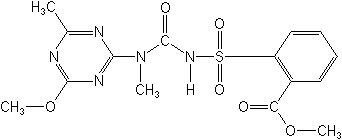Products >> Herbicides >> Tribenuron-Methyl
Tribenuron-Methyl
Tribenuron-Methyl 95%TC
Tribenuron-Methyl 75%WG
Herbicide
HRAC B WSSA 2; sulfonylurea

NOMENCLATURE Tribenuron-Methyl
Chemical Abstracts name methyl 2-[[[[(4-methoxy-6-methyl-1,3,5-triazin-2-yl)methylamino]carbonyl]amino]sulfonyl]benzoate
CAS RN [101200-48-0] EEC no. 401-190-1 Development codes DPX-L5300
(Du Pont); L5300
tribenuron
Common name tribenuron (BSI, ANSI, draft E-ISO)
IUPAC name 2-[4-methoxy-6-methyl-1,3,5-triazin-2-yl(methyl)carbamoylsulfamoyl]benzoic
acid
Chemical Abstracts name 2-[[[[(4-methoxy-6-methyl-1,3,5-triazin-2-yl)methylamino]carbonyl]amino]sulfonyl]benzoic
acid
CAS RN [106040-48-6]
Tribenuron-Methyl APPLICATIONS
Biochemistry Branched chain amino acid synthesis (ALS or AHAS) inhibitor.
Acts by inhibiting biosynthesis of the essential amino acids valine
and isoleucine, hence stopping cell division and plant growth. Selectivity
derives from rapid metabolism in the crop. Metabolic basis of selectivity
in sulfonylureas reviewed (M. K. Koeppe & H. M. Brown, Agro-Food-Industry,
6, 9-14 (1995)). Mode of action Rapidly absorbed by foliage and
roots and translocated throughout the plant. Susceptible plants
cease growth almost immediately after post-emergence treatment and
are killed in 7-21 days. Surfactants increase the activity of tribenuron-methyl
on certain broad-leaved weeds. Uses Post-emergence control of broad-leaved
weeds in spring and winter cereals, at 9-30 g/ha. Formulation types
TB; WG. Selected tradenames: 'Express' (USA) (Du Pont); 'Granstar'
(Europe) (Du Pont); 'Pointer' (Germany) (Du Pont)
Tribenuron-Methyl OTHER TRADENAMES
'Cameo' (Du Pont); 'Quantum 75' (Du Pont); 'Quantum' (Du Pont);
'Oscar' (Vapco) mixtures: 'Calibre' (+ thifensulfuron-methyl) (Du
Pont); 'Canvas' (+ METSULFURON-METHYL+ THIFENSULFURON-METHYL) (Du
Pont); 'DUK 110' (+ thifensulfuron-methyl) (Du Pont); 'Harmony Extra'
(+ thifensulfuron-methyl) (Du Pont)
Tribenuron-Methyl ANALYSIS
Product and residue analysis by hplc. Methods for sulfonylurea residues
in crops, soil and water reviewed (A. C. Barefoot et al., Proc.
Br. Crop Prot. Conf. - Weeds, 1995, 2, 707).
Tribenuron-Methyl MAMMALIAN TOXICOLOGY
Oral Acute oral LD50 for rats >5000 mg/kg. Skin and eye Acute
percutaneous LD50 for rabbits >2000 mg/kg. Non-irritating to
skin (rabbits); mild (reversible) irritant to eyes. Mildly sensitising
to skin (guinea pig maximisation test). Inhalation LC50 (4 h) for
rats >5.0 mg/l air. NOEL (2 y) for rats 25 ppm diet; (18 mo)
for mice 200 ppm diet (30 mg/kg b.w. daily); (1 y) for dogs 250
ppm diet (8.2 mg/kg b.w. daily); (90 d) for rats 100, for mice 500,
for dogs 500 mg/kg diet. Non-teratogenic in rats at 20 mg/kg daily.
ADI 0.008 mg/kg. Other Non-mutagenic in the Ames test, and negative
in CHO, unscheduled DNA, in vivo cytogenetic, in vivo mouse micronucleus,
and in vitro human lymphocyte assays. Toxicity class WHO (a.i.)
III (Table 5); EPA (formulation) III EC hazard R43
Tribenuron-Methyl ECOTOXICOLOGY
Birds Acute oral LD50 for bobwhite quail >2250 mg/kg. Dietary
LC50 (8 d) for bobwhite quail and mallard ducks >5620 mg/kg.
Fish LC50 (96 h) for bluegill sunfish and rainbow trout >1000
mg/l. Daphnia LC50 (48 h) 720 mg/l (unfed), 1000 mg/l (fed). Algae
EC50 (120 h) for green algae and blue-green algae >11.5 mg/l.
Bees LD50 for honeybees >100 mg/bee. Worms LD50 for earthworms
>2000 ppm.
Tribenuron-methyl ENVIRONMENTAL FATE
Soil/Environment Half-life of tribenuron-methyl in soil 1-7 days.
No significant photodecomposition under field conditions. Degradation
in the soil occurs by hydrolysis and by direct microbial degradation.
Hydrolysis is affected by soil pH, being faster in acidic than alkaline
soils. Losses due to volatilisation are not significant.